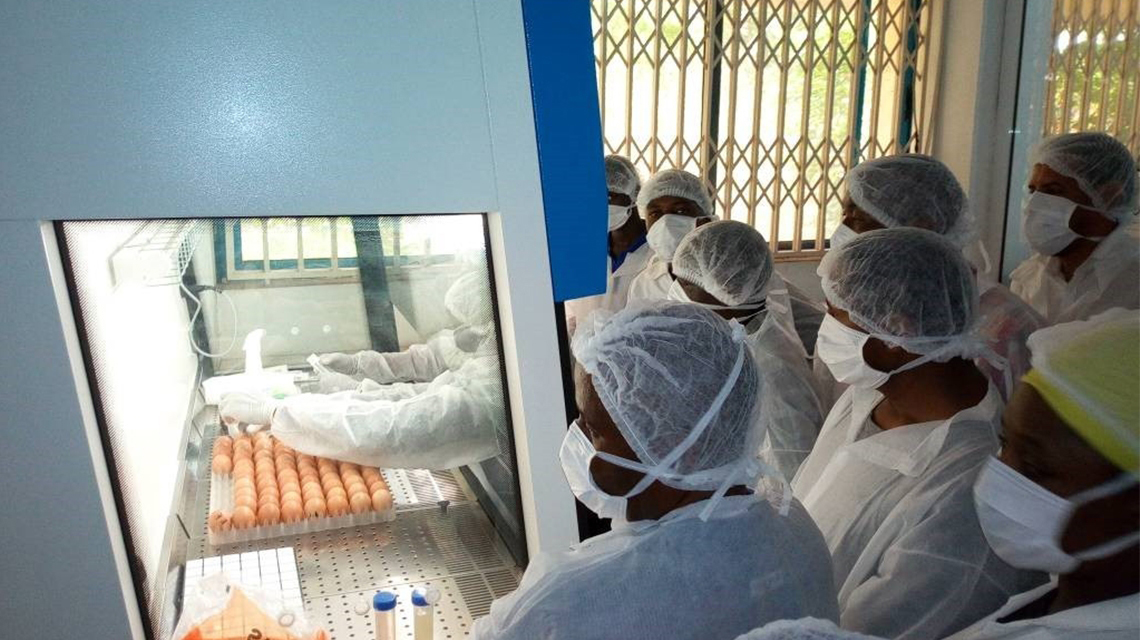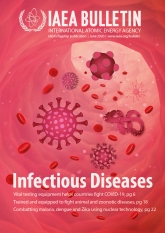
If you would like to learn more about the IAEA’s work, sign up for our weekly updates containing our most important news, multimedia and more.
Trained and equipped to fight animal and zoonotic diseases
Carley Willis, Nicole Jawerth

The AVL team carrying out training on analyzing unhatched eggs to determine exposure to the avian influenza virus. (Photo: IAEA)
Trained and equipped to fight animal and zoonotic diseases
Hundreds of infectious animal diseases are out there, and, without the right preventative measures, they can strike at any time. While most of these diseases spread only between animals, some can jump from animals to people; these are called zoonotic diseases. To help tackle these threats to animals, people and economies, the right training and equipment in diagnostics is needed. One of the ways specialists get that is through support from the IAEA, in partnership with the Food and Agriculture Organization of the United Nations (FAO).
“In some countries there is limited capacity to effectively control diseases that hinder livestock production. This was the case for the Accra Veterinary Laboratory (AVL),” said Joseph Awuni, Deputy Director and Head of the Veterinary Services Directorate at the AVL, in Ghana. “Through IAEA and FAO support, the AVL can now handle major animal disease outbreaks, and the laboratory is also considered a regional support laboratory in West Africa, as we are now able to provide diagnostic support and training to neighbouring countries.”
For decades, specialists like those at the AVL have worked with the IAEA and FAO to improve their capacities to use nuclear, nuclear-derived and other methods to detect and diagnose animal and zoonotic diseases. These diagnostic methods are key to preventing, controlling and, when possible, eradicating these diseases, which can have disastrous consequences for animal and human health, as well as for communities and economies.
“ Through IAEA and FAO support, the AVL can now handle major animal disease outbreaks.
Outbreaks test skills
The AVL team’s capabilities were put to the test in 2018, when an outbreak of avian influenza virus — a highly contagious infection causing a high rate of organ damage and death in domesticated birds such as chickens — was spotted in isolated areas around Boankra, in Ghana’s Ashanti region. The team used their training and newly installed equipment to rapidly diagnose the disease using nuclear-derived and other techniques, as well as to assist with early containment, preventing a major economic blow to the region’s poultry industry.
In that same year, African swine fever also began spreading across Ghana, threatening the country’s pork industry. The AVL team immediately launched an active surveillance and culling campaign for affected pig farms and put in place tight restrictions on animal movement. In addition to collecting and testing tissue samples, they also began routinely using molecular diagnostics, which helped them to rapidly and accurately diagnose 27 suspected outbreaks of the disease.
While the source of the outbreaks was uncertain, the AVL team suspected the outbreaks came from contact with wild pigs. Most of Ghana’s pig population is raised in areas of open forest, and African swine fever often spreads to domesticated pigs from wild boar or warthogs. To find the source of infection, the AVL team worked with experts from the IAEA and FAO to use a nuclear-related technique called real time reverse transcription–polymerase chain reaction (real time RT–PCR) to detect avian influenza, as well as real time polymerase chain reaction (real time PCR) to detect African swine fever in tissue samples.
“Identifying the source of an infection is always important for taking appropriate steps,” said Hermann Unger, Technical Officer at the Animal Production and Health Section of the Joint FAO/IAEA Division of Nuclear Techniques in Food and Agriculture. “A wildlife survey was initiated, and blood samples and ticks were collected from boar. All samples were tested with nuclear-derived molecular methods, and none were found to contain the virus. This meant the infection was among domesticated livestock. In response, biosafety measures were introduced into livestock markets and the outbreak was stopped.”
Early disease detection
Early detection is key to preventing and controlling the spread of diseases. In Bosnia and Herzegovina, this is central to how they have been controlling brucellosis, bluetongue (BT) and lumpy skin disease (LSD).
For centuries, brucellosis — transmitted through direct and indirect contact between animals — has been an endemic disease in livestock in the Balkan Peninsula, while BT and LSD — transmitted by blood-sucking insects such as mosquitoes, ticks, midges and fleas — have emerged recently in the area. These diseases threaten animal health and production, as well as the livelihoods of farmers and their families. They also have an impact on the country’s exports.
With support from the IAEA and FAO, in part through the IAEA’s technical cooperation programme, specialists in Bosnia and Herzegovina can now read entire genome sequences and identify virus strains. In the past, this required support from international reference laboratories, which delayed detection, diagnosis and intervention. The specialists now also have access to high-tech laboratory equipment and consumables, enabling them to deepen their understanding of the epidemiology of BT and LSD using molecular tools such as whole genome sequencing and bioinformatics.
In 2020, “due to the presence of brucellosis in Bosnia and Herzegovina, the export of live animals is still not allowed by the European Union. However, thanks to the milestone we have reached in performing diagnostic tests quickly and reliably, we have made a big step towards fulfilling the standards of the European Union,” said Toni Eterovic, a research scientist at the Faculty of Veterinary Medicine of the University of Sarajevo who took part in the project.
VETLAB Network
The Joint FAO/IAEA Veterinary Diagnostic Laboratory Network, or VETLAB Network, connects national laboratories worldwide in order to tackle animal and zoonotic diseases, which recognize no borders and can threaten livestock, farmers’ livelihoods and public health. The VETLAB Network’s association of laboratories, including the Joint FAO/IAEA Animal Production and Health Laboratory, work to build capacities for using nuclear, nuclear-derived and other methods for monitoring, early detection, diagnosis and control of animal and zoonotic diseases. These activities include expert advice and services, sharing data, knowledge and expertise, training courses and technology transfer.
The VETLAB Network’s overall goal is to harmonize collaboration across borders for more effective prevention, detection and response to animal and zoonotic diseases.

